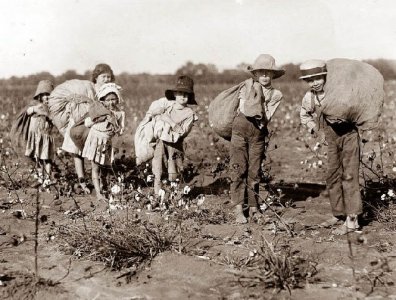You are using an out of date browser. It may not display this or other websites correctly.
You should upgrade or use an alternative browser.
You should upgrade or use an alternative browser.
History, anything goes, including pictures
- Thread starter mellowyellow
- Start date
RadishRose
SF VIP
- Location
- Connecticut, USA
Surrender!
RadishRose
SF VIP
- Location
- Connecticut, USA
mellowyellow
Well-known Member
Brilliant video, thanks Radish
mellowyellow
Well-known Member
I hate to think what would have happened to little old Oz if America hadn't taken charge in the Battle of the Coral Sea, thanks guys, much appreciated.
FastTrax
Well-known Member
RnR
Member
- Location
- Gold Coast, Queensland
At 100 years old, John Russell is the last surviving member of Australia's first Antarctic station team.

In a quiet suburban street north of Brisbane is a hidden treasure trove of Australia's Antarctic history, in the form of 100-year-old John Russell. A former engineer, John is the last surviving member of a 10-man team who first established Mawson Station in 1954, huddled on exposed rock, surrounded by ice — the longest permanently operating station south of the Antarctic Circle.
The 10-man team that established Australia's Mawson Station in 1954, pictured at the station, Australian Antarctic Division.

Full ABC story.

In a quiet suburban street north of Brisbane is a hidden treasure trove of Australia's Antarctic history, in the form of 100-year-old John Russell. A former engineer, John is the last surviving member of a 10-man team who first established Mawson Station in 1954, huddled on exposed rock, surrounded by ice — the longest permanently operating station south of the Antarctic Circle.
The 10-man team that established Australia's Mawson Station in 1954, pictured at the station, Australian Antarctic Division.

Full ABC story.
mellowyellow
Well-known Member
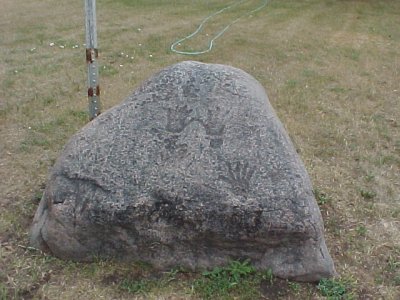
Prayer Rock Petroglyphs
Many years ago, a glacial boulder was discovered, southeast of Mobridge, South Dakota, which weighs about five tons and has life-sized human hands etched on it. A well-beaten trail led to the site. Archeologists think Native Americans may have placed their hands in the imprints while praying. The rock was moved to the public library grounds in Ipswich, South Dakota, care being taken to orient the stone precisely as it originally lay. The sign accompanying the rock reads "Medicine or Prayer Rock." Part of the inscription mentions that this rock was a symbol of great power and venerated by the Indians who believed it the work of the Wakan or Great Spirit. The public library in Ipswich is located on Main Street, about four blocks south of U.S. Highway 12, also known as the Yellowstone Trail.
RnR
Member
- Location
- Gold Coast, Queensland
8 February 1942 – The Battle of Singapore begins when Japanese forces invade the British stronghold.
The fighting in Singapore lasted from 8 to 15 February 1942, after the two months during which Japanese forces had advanced down the Malayan Peninsula. The British stronghold in Singapore was deemed to be an impregnable fortress. The British air and naval bases commissioned in 1939 and 1941 respectively were impressive and intimidating. The King George VI Graving Dock at the naval base was the largest dry dock in the world, scaling a full 300 meters to show the capacity of the British Malayan Navy.
Lieutenant-General Arthur Ernest Percival, right, led by a Japanese officer, walks under a flag of truce to negotiate the capitulation of
Allied forces in Singapore, on 15 February 1942.
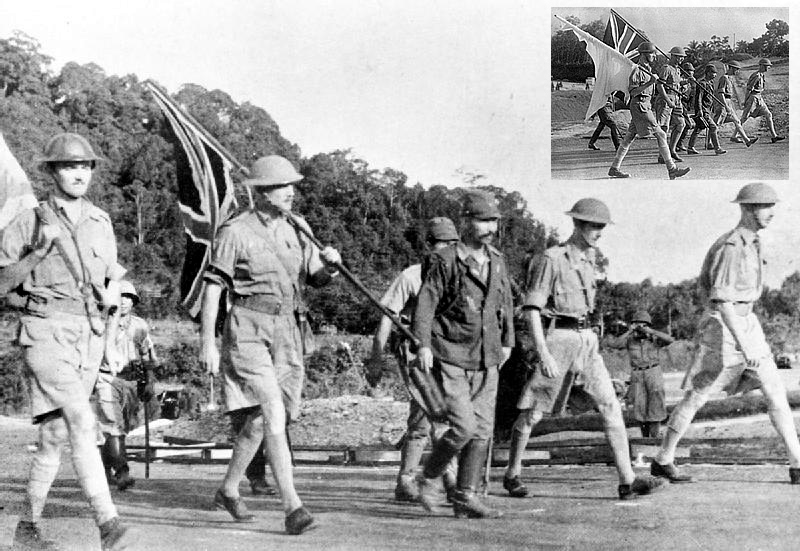
It was the largest surrender of British-led forces in history.
The Japanese were very swift, employing bicycles as a means of movement through the jungle terrain. Using a combination of bicycles and collapsible boats, they outflanked and encircled the British army in North Malaya, cutting off their supply lines. On 31 January 1942, the causeway at Johore Baharu which linked Malaya and Singapore was blown up by the Japanese, resulting in a fifty-metre gap. The Battle of Singapore ended with the surrender of the British on 15th February 1942, by which time half of Singapore was already occupied by the Japanese.
Some of the British, Australian, Indian and Chinese forces captured by Japanese forces during the fall of Singapore, 15 February 1942.

This defeat was a crushing blow to the British Empire, and one that signalled the start of the defection of Australia’s foreign policy away from the United Kingdom. Australian Prime Minister John Curtin, told Churchill that Australia would regard the act of surrender as an inexcusable betrayal.
The British prime minister, Winston Churchill, called it the “worst disaster” in British military history.
The fighting in Singapore lasted from 8 to 15 February 1942, after the two months during which Japanese forces had advanced down the Malayan Peninsula. The British stronghold in Singapore was deemed to be an impregnable fortress. The British air and naval bases commissioned in 1939 and 1941 respectively were impressive and intimidating. The King George VI Graving Dock at the naval base was the largest dry dock in the world, scaling a full 300 meters to show the capacity of the British Malayan Navy.
Lieutenant-General Arthur Ernest Percival, right, led by a Japanese officer, walks under a flag of truce to negotiate the capitulation of
Allied forces in Singapore, on 15 February 1942.

It was the largest surrender of British-led forces in history.
The Japanese were very swift, employing bicycles as a means of movement through the jungle terrain. Using a combination of bicycles and collapsible boats, they outflanked and encircled the British army in North Malaya, cutting off their supply lines. On 31 January 1942, the causeway at Johore Baharu which linked Malaya and Singapore was blown up by the Japanese, resulting in a fifty-metre gap. The Battle of Singapore ended with the surrender of the British on 15th February 1942, by which time half of Singapore was already occupied by the Japanese.
Some of the British, Australian, Indian and Chinese forces captured by Japanese forces during the fall of Singapore, 15 February 1942.

This defeat was a crushing blow to the British Empire, and one that signalled the start of the defection of Australia’s foreign policy away from the United Kingdom. Australian Prime Minister John Curtin, told Churchill that Australia would regard the act of surrender as an inexcusable betrayal.
The British prime minister, Winston Churchill, called it the “worst disaster” in British military history.
mellowyellow
Well-known Member
February 8

An illustration of the demon called Buer. He has the head of a lion and five goat legs surrounding his body to walk in every direction.
Something strange happened on the cold night of 8 February 1855 around the Exe Estuary in Devon, England. That winter was extremely cold. According to reports from the time, temperatures remained around freezing from January until March. The low temperatures didn’t allow snow to melt and every new snowfall just added a new layer over the terrain. These extreme weather conditions were the perfect set up for the strange events of that night.
According to the few witness accounts from that time, after a heavy snowfall on the night of 8 February 1855, mysterious hoof marks appeared all over South and East Devon. The hoof marks were reported to be around four inches long, three inches across, between eight and sixteen inches apart and mostly in a single file. Reports about these footprints came from around 30 different locations in Devon. The combined footprints had a reported length of between 40 and 100 miles. It seemed like the “creature” that left the traces could overcome any obstacle. Footprints were found over houses, frozen rivers, haystacks, snow-covered roofs, high walls, and also inside drain pipes. Here is a part of one news report that describes the event:………….
https://www.thevintagenews.com/2016/10/12/the-1855-devils-footprints-mystery-in-devon-england/

An illustration of the demon called Buer. He has the head of a lion and five goat legs surrounding his body to walk in every direction.
Something strange happened on the cold night of 8 February 1855 around the Exe Estuary in Devon, England. That winter was extremely cold. According to reports from the time, temperatures remained around freezing from January until March. The low temperatures didn’t allow snow to melt and every new snowfall just added a new layer over the terrain. These extreme weather conditions were the perfect set up for the strange events of that night.
According to the few witness accounts from that time, after a heavy snowfall on the night of 8 February 1855, mysterious hoof marks appeared all over South and East Devon. The hoof marks were reported to be around four inches long, three inches across, between eight and sixteen inches apart and mostly in a single file. Reports about these footprints came from around 30 different locations in Devon. The combined footprints had a reported length of between 40 and 100 miles. It seemed like the “creature” that left the traces could overcome any obstacle. Footprints were found over houses, frozen rivers, haystacks, snow-covered roofs, high walls, and also inside drain pipes. Here is a part of one news report that describes the event:………….
https://www.thevintagenews.com/2016/10/12/the-1855-devils-footprints-mystery-in-devon-england/
What makes you think it is a male?Care to give us more info? Who is this and what was his historical significance?
mellowyellow
Well-known Member
It was a shocking blow.8 February 1942 – The Battle of Singapore begins when Japanese forces invade the British stronghold.
The fighting in Singapore lasted from 8 to 15 February 1942, after the two months during which Japanese forces had advanced down the Malayan Peninsula. The British stronghold in Singapore was deemed to be an impregnable fortress. The British air and naval bases commissioned in 1939 and 1941 respectively were impressive and intimidating. The King George VI Graving Dock at the naval base was the largest dry dock in the world, scaling a full 300 meters to show the capacity of the British Malayan Navy.
Lieutenant-General Arthur Ernest Percival, right, led by a Japanese officer, walks under a flag of truce to negotiate the capitulation of
Allied forces in Singapore, on 15 February 1942.

It was the largest surrender of British-led forces in history.
The Japanese were very swift, employing bicycles as a means of movement through the jungle terrain. Using a combination of bicycles and collapsible boats, they outflanked and encircled the British army in North Malaya, cutting off their supply lines. On 31 January 1942, the causeway at Johore Baharu which linked Malaya and Singapore was blown up by the Japanese, resulting in a fifty-metre gap. The Battle of Singapore ended with the surrender of the British on 15th February 1942, by which time half of Singapore was already occupied by the Japanese.
Some of the British, Australian, Indian and Chinese forces captured by Japanese forces during the fall of Singapore, 15 February 1942.

This defeat was a crushing blow to the British Empire, and one that signalled the start of the defection of Australia’s foreign policy away from the United Kingdom. Australian Prime Minister John Curtin, told Churchill that Australia would regard the act of surrender as an inexcusable betrayal.
The British prime minister, Winston Churchill, called it the “worst disaster” in British military history.
RadishRose
SF VIP
- Location
- Connecticut, USA
These things fascinate me. Most of my life I have wanted framed replicas of the cave drawings in France and I don't know why I never did!View attachment 148591
Prayer Rock Petroglyphs
Many years ago, a glacial boulder was discovered, southeast of Mobridge, South Dakota, which weighs about five tons and has life-sized human hands etched on it. A well-beaten trail led to the site. Archeologists think Native Americans may have placed their hands in the imprints while praying. The rock was moved to the public library grounds in Ipswich, South Dakota, care being taken to orient the stone precisely as it originally lay. The sign accompanying the rock reads "Medicine or Prayer Rock." Part of the inscription mentions that this rock was a symbol of great power and venerated by the Indians who believed it the work of the Wakan or Great Spirit. The public library in Ipswich is located on Main Street, about four blocks south of U.S. Highway 12, also known as the Yellowstone Trail.
Anyway, to quote an article-
"
The Susquehanna’s Mysterious Petroglyphs
Travel through the Southwest and petroglyphs are readily on view in national parks such as Canyonlands, Arches and Dinosaur, all of which are located in Utah. But, you don’t have to travel across the country to see these mysterious forms of ancient communication. Petroglyphs can be seen in South Central Pennsylvania!"
https://www.lancastercountymag.com/the-susquehannas-mysterious-petroglyphs/mellowyellow
Well-known Member
Frenchman who would be king wants to live rent-free

The Count of Paris is demanding €1 million in damages and the return of the Château d’Amboise, in the Loire Valley, and the Royal Chapel of Dreux
MICHEL GILE/GETTY IMAGES; PHILIPPE WOJAZER/REUTERS
Royalists and republicans are heading for a new showdown in France where a pretender to the defunct throne is suing the foundation that manages his family’s former estate.
Jean d’Orléans, the Count of Paris, 55, is demanding €1 million in damages from the Saint-Louis Foundation and the return of properties, including the Château d’Amboise, in the Loire Valley, and the Royal Chapel of Dreux, west of Paris. The foundation has been under the supervision of the interior ministry since its creation in 1974 by his grandfather, Prince Henry VI of Orléans.
Source: The Times

The Count of Paris is demanding €1 million in damages and the return of the Château d’Amboise, in the Loire Valley, and the Royal Chapel of Dreux
MICHEL GILE/GETTY IMAGES; PHILIPPE WOJAZER/REUTERS
Royalists and republicans are heading for a new showdown in France where a pretender to the defunct throne is suing the foundation that manages his family’s former estate.
Jean d’Orléans, the Count of Paris, 55, is demanding €1 million in damages from the Saint-Louis Foundation and the return of properties, including the Château d’Amboise, in the Loire Valley, and the Royal Chapel of Dreux, west of Paris. The foundation has been under the supervision of the interior ministry since its creation in 1974 by his grandfather, Prince Henry VI of Orléans.
Source: The Times
mellowyellow
Well-known Member
February 9
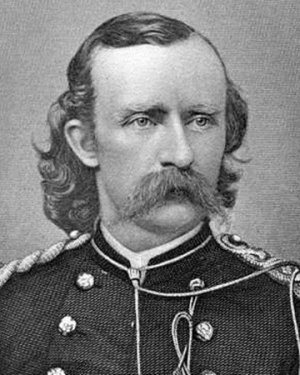
1864 Brigadier General George Armstrong Custer marries Elizabeth Clift Bacon
Although Custer graduated last in his class at West Point Military Academy, he quickly rose to prominence during the US Civil War. He became the protégé of Major General Alfred Pleasonton who appointed him Brigadier General just before the Battle of Gettysburg in 1863.
Born: 5 December 1839
Died: 25 June 1876 (aged 36)
Cause of Death: Killed in battle

1864 Brigadier General George Armstrong Custer marries Elizabeth Clift Bacon
Although Custer graduated last in his class at West Point Military Academy, he quickly rose to prominence during the US Civil War. He became the protégé of Major General Alfred Pleasonton who appointed him Brigadier General just before the Battle of Gettysburg in 1863.
Born: 5 December 1839
Died: 25 June 1876 (aged 36)
Cause of Death: Killed in battle
RadishRose
SF VIP
- Location
- Connecticut, USA
Sounds like the grandfather, Prince Henry VI of Orléans "willed" to the Foundation.
rgp
Well-known Member
- Location
- Milford,OH
These things fascinate me. Most of my life I have wanted framed replicas of the cave drawings in France and I don't know why I never did!
Anyway, to quote an article-
"
The Susquehanna’s Mysterious Petroglyphs
Travel through the Southwest and petroglyphs are readily on view in national parks such as Canyonlands, Arches and Dinosaur, all of which are located in Utah. But, you don’t have to travel across the country to see these mysterious forms of ancient communication. Petroglyphs can be seen in South Central Pennsylvania!"
https://www.lancastercountymag.com/the-susquehannas-mysterious-petroglyphs/
I'll wager that there are many of them {Petroglyphs} all over the nation. It's just that even after roughly 500+years of being here, we haven't found so many of them yet !
RnR
Member
- Location
- Gold Coast, Queensland
9 February 1884 – Arthur Stace, the man who chalked “Eternity” on Sydney footpaths for 37 years, is born.
Mr Arthur Stace became a Sydney legend for chalking the word “Eternity” on footpaths across Sydney, spanning 35 years. Born in Redfern in inner west Sydney in 1885, Stace grew up in poverty, stealing bread and milk and scrounging for scraps in bins to survive. At the age of 7, Arthur was given up to foster care by his Mother, and was sent to Goulburn where he spent the next seven years living with an elderly widow. He attended school and had a basic education.
By the age of 14, Arthur was working in a South Coast coal mine. With his first pay, he went to the local hotel where he purchased his first alcoholic drink. By the end of that same year, he was carted off to jail drunk. Drinking became a habit, and soon enough Arthur was an alcoholic. Later he served in World War 1, and was discharged in 1919 after recurring bouts of bronchitis and pleurisy. Despite these harsh beginnings, from 1932 to 1967 Stace went on to gain fame as a reformed alcoholic who converted to Christianity and spread his message of hope by chalking the word “Eternity” on footpaths in and around Sydney.

Stace was inspired to what became his life’s working after hearing a sermon entitled “Echoes of Eternity”. At the end of the sermon, Rev John Ridley raised his voice and said, “Eternity! Eternity! I wish that I could sound, or shout that word to everyone on the streets. Eternity! Friends, you have got to meet it. Where will you spend Eternity?” In an interview, Arthur Stace later said, “Eternity went ringing through my brain and suddenly I began crying and felt a powerful call from the Lord to write “Eternity”. I had a piece of chalk in my pocket and outside the Church, I bent down right there and wrote it.” To his astonishment, the word came out smoothly, in perfect copperplate. He had always struggled with reading and writing and never thought he could write or spell the word. Arthur believed it was a gift from God.
Arthur Stace “Mr Eternity” Memorial.

Driven by the hope his message might inspire others to lead a better life, several mornings a week for the next 35 years, Stace left his wife, Pearl and their home in Pyrmont around 5am to go around the streets of Sydney and chalk the word “Eternity” on footpaths, railway station entrances and anywhere else he could think of. It is estimated that he wrote the word around 500,000 times over the 35 years. Workers arriving in the city would see the word freshly written, but not the writer, and so, “The man who writes Eternity” became a legend in Sydney.
In 1999, at the start of a new millennium and as a fitting tribute to Stace, “Eternity” was emblazoned across Sydney Harbour Bridge as a part of the Sydney’s New Year’s Eve celebrations.

When Stace died in 1967, his final act of benevolence was to bequeath his body to science, so that it might help others, perhaps inspired by his own visions of eternity. Two years after his death, his earthly remains were laid to rest with those of his wife at Eastern Suburbs Memorial Park.
Mr Arthur Stace became a Sydney legend for chalking the word “Eternity” on footpaths across Sydney, spanning 35 years. Born in Redfern in inner west Sydney in 1885, Stace grew up in poverty, stealing bread and milk and scrounging for scraps in bins to survive. At the age of 7, Arthur was given up to foster care by his Mother, and was sent to Goulburn where he spent the next seven years living with an elderly widow. He attended school and had a basic education.
By the age of 14, Arthur was working in a South Coast coal mine. With his first pay, he went to the local hotel where he purchased his first alcoholic drink. By the end of that same year, he was carted off to jail drunk. Drinking became a habit, and soon enough Arthur was an alcoholic. Later he served in World War 1, and was discharged in 1919 after recurring bouts of bronchitis and pleurisy. Despite these harsh beginnings, from 1932 to 1967 Stace went on to gain fame as a reformed alcoholic who converted to Christianity and spread his message of hope by chalking the word “Eternity” on footpaths in and around Sydney.

Stace was inspired to what became his life’s working after hearing a sermon entitled “Echoes of Eternity”. At the end of the sermon, Rev John Ridley raised his voice and said, “Eternity! Eternity! I wish that I could sound, or shout that word to everyone on the streets. Eternity! Friends, you have got to meet it. Where will you spend Eternity?” In an interview, Arthur Stace later said, “Eternity went ringing through my brain and suddenly I began crying and felt a powerful call from the Lord to write “Eternity”. I had a piece of chalk in my pocket and outside the Church, I bent down right there and wrote it.” To his astonishment, the word came out smoothly, in perfect copperplate. He had always struggled with reading and writing and never thought he could write or spell the word. Arthur believed it was a gift from God.
Arthur Stace “Mr Eternity” Memorial.

Driven by the hope his message might inspire others to lead a better life, several mornings a week for the next 35 years, Stace left his wife, Pearl and their home in Pyrmont around 5am to go around the streets of Sydney and chalk the word “Eternity” on footpaths, railway station entrances and anywhere else he could think of. It is estimated that he wrote the word around 500,000 times over the 35 years. Workers arriving in the city would see the word freshly written, but not the writer, and so, “The man who writes Eternity” became a legend in Sydney.
In 1999, at the start of a new millennium and as a fitting tribute to Stace, “Eternity” was emblazoned across Sydney Harbour Bridge as a part of the Sydney’s New Year’s Eve celebrations.

When Stace died in 1967, his final act of benevolence was to bequeath his body to science, so that it might help others, perhaps inspired by his own visions of eternity. Two years after his death, his earthly remains were laid to rest with those of his wife at Eastern Suburbs Memorial Park.
squatting dog
Remember when... thirty seemed so old.
- Location
- Arkansas, and also Florida
mellowyellow
Well-known Member
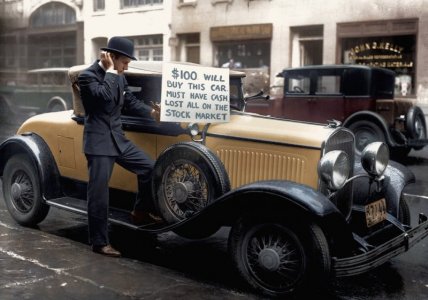
Bankrupt investor Walter Thornton tries to sell his luxury roadster for $100 cash on the streets of New York City following the 1929 stock market crash
The car pictured in this photograph was a 1929 Chrysler 75 and sold new for around $1555 at the time. That would equal about $23,000 today. The $100 asking price after the crash would be about $1500 today.
Walter Thornton (pictured) recovered quickly after the stock crash and started a modelling agency in 1929. As the Walter Thornton Modelling Agency grew, it was considered one of the "Big Three" and one of the largest model agencies in the United States. The agency was known for its World War II era pin-up girls.
https://en.wikipedia.org/wiki/Walter_Clarence_Thornton
mellowyellow
Well-known Member
February 10
Tom and Jerry cartoon created by William Hanna and Joseph Barbera debut by MGM on this day in 1940

William Hanna formed a partnership with Joseph Barbera in 1957 after they have created "Tom and Jerry" (1940). They became the first animation studio to successfully produce animation especially for television.
Some of their best-known series include "The Huckleberry Hound Show" (1958), "The Flintstones" (1960), "The Jetsons" (1962) and "The Smurfs" (1981).
Together they have won six Emmy Awards and were nominated for two Academy Awards. They won the first Emmy for an animated programme.
Tom and Jerry cartoon created by William Hanna and Joseph Barbera debut by MGM on this day in 1940

William Hanna formed a partnership with Joseph Barbera in 1957 after they have created "Tom and Jerry" (1940). They became the first animation studio to successfully produce animation especially for television.
Some of their best-known series include "The Huckleberry Hound Show" (1958), "The Flintstones" (1960), "The Jetsons" (1962) and "The Smurfs" (1981).
Together they have won six Emmy Awards and were nominated for two Academy Awards. They won the first Emmy for an animated programme.
RnR
Member
- Location
- Gold Coast, Queensland
February 10
Tom and Jerry cartoon created by William Hanna and Joseph Barbera debut by MGM on this day in 1940
View attachment 148896
William Hanna formed a partnership with Joseph Barbera in 1957 after they have created "Tom and Jerry" (1940). They became the first animation studio to successfully produce animation especially for television.
Some of their best-known series include "The Huckleberry Hound Show" (1958), "The Flintstones" (1960), "The Jetsons" (1962) and "The Smurfs" (1981).
Together they have won six Emmy Awards and were nominated for two Academy Awards. They won the first Emmy for an animated programme.



![a3588002116e991e16ca4747cb2aa3f2[1].jpg a3588002116e991e16ca4747cb2aa3f2[1].jpg](https://www.seniorforums.com/data/attachments/125/125318-24c124dfcb637ca90409f401c920c44a.jpg)

![57225eda833d362f46b10631e66b6ff4[1].jpg 57225eda833d362f46b10631e66b6ff4[1].jpg](https://www.seniorforums.com/data/attachments/125/125541-4143b20ab6513ee1b9f2900c823503ed.jpg)
